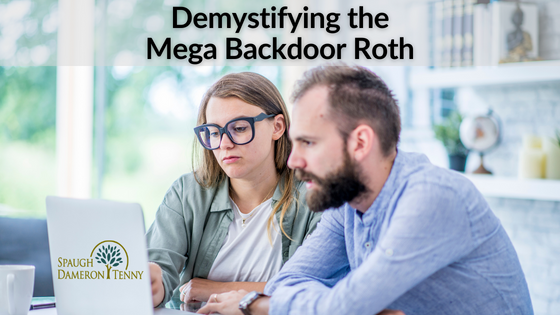Have you ever heard of the mega backdoor Roth and wondered if it's just another term for a secret financial handshake? Let's break it down without the financial jargon.

Imagine earning a hefty income, but the Roth IRA doors are closed because you've crossed the income threshold ($146,000 per year single or $230,000 per year married, filing jointly). Enter the mega backdoor Roth.
A mega backdoor Roth takes a Roth IRA to the next level. In simple terms, the mega backdoor Roth is a strategy that allows individual investors to contribute more to a Roth IRA and/or Roth 401(k) than the standard contribution limits. It can be beneficial to those who usually face barriers to contributing to a Roth IRA due to high income or contribution limits.
Is the mega backdoor Roth right for you? Some factors include:
You cannot make the after-tax contributions required for a mega backdoor Roth IRA until you've reached your 401(k) employee contribution limit.
If you stick to pre-tax and/or Roth contributions, you max out at $23,000 (or $30,500 if you're 50 or older). Add in after-tax contributions, and you could potentially push the savings ceiling to $69,000 (or $76,500 for those 50 and older).
Upon reaching the annual contribution limit for pre-tax, Roth, and after-tax amounts in a given calendar year, your employer might face restrictions on additional contributions. Additionally, based on your specific plan, after-tax contributions may not qualify for an employer match.
The mega backdoor Roth strategy involves two key steps:
Start by contributing after-tax dollars into your 401(k) or workplace retirement plan. This is a distinct form of contribution, separate from pre-tax and Roth contributions. This move lets you surpass the usual contribution limits.
The second step entails the conversion of after-tax contributions to a Roth account, either through an in-plan Roth conversion to a Roth 401(k) or a rollover to a Roth IRA if permitted by the plan. Some companies even offer an auto-convert feature — set it and forget it.
It's essential to be aware that taxes apply to the earnings included in the conversion, excluding the already-taxed contributions. It's advisable to promptly roll over your funds to minimize the potential taxation of investment gains during the mega backdoor Roth conversion.
Swift conversion is preferred to avoid taxable gains, allowing them to occur within the Roth IRA, where they can grow tax-free and be withdrawn without tax implications. Seeking advice from a tax professional is advisable to understand the potential tax effects specific to your situation.
In many cases, the specifics of your employer-sponsored retirement plan will determine whether you are eligible for this conversion strategy.
Here are some things to know:
The mega backdoor Roth might face uncertainty ahead. Legislative changes like the Build Back Better Act have flirted with shutting down the strategy by restricting conversions of after-tax 401(k) contributions to Roth.
While the act hasn't passed Congress yet, similar measures are still floating around. Until legislation officially pulls the plug, the mega backdoor Roth remains a viable strategic move.
A mega backdoor Roth is a strategy that allows investors — who typically are excluded based on their high income or contribution limits — to move specific 401(k) contributions into a Roth IRA. So, it depends on your situation.
Remember, not everyone is eligible for this type of conversion strategy. Check if your workplace plan is mega backdoor friendly. Consider your current retirement savings, financial goals, and tax situation.
Before getting started, consider reaching out to a tax professional or financial advisor who can provide you with guidance for your specific situation. Our financial planners can help determine if the mega backdoor Roth is right for you.
CRN202701-5784149

Megan Robinson, FPQP™, CRPS®, serves as the investment coordinator at Spaugh Dameron Tenny, where she oversees account transfers, monitors client portfolios, and implements tailored investment strategies. With certifications in financial planning and retirement plan design, Megan ensures that the operational side of wealth management runs smoothly and accurately. Known for her attention to detail and client-first mindset, she plays a crucial behind-the-scenes role in providing executives, physicians, dentists, and retirees with efficient, coordinated financial care.
Understanding how much you can contribute toward retirement each year helps you stay on track with long-term financial goals and avoid surprises at ...
Read More →Have you ever considered the benefits of gifting appreciated assets?
Read More →Have you ever felt like you're falling behind or wondered if you’re on the right track for a stress-free retirement?
Read More →